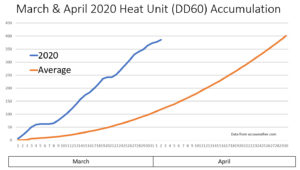When I first moved down to Port Lavaca, at a crop tour, growers were talking how much experience they had farming. One replied he had “1 year experience, 40 times.”
I think there is a lot of truth to that statement. It seems each year presents it’s own production challenges.
So how is 2020 different from other years? There are two obvious differences: lower than normal rainfall and higher than average temperatures.
Much of insect and plant activity occurs as a response to three variables. These variables are day length, temperature, and moisture. Day length is constant from year to year, but temperature and moisture are in a constant state of change. While we are accustomed to periods of drought, the last 9 months have been well below average for much of the area. Temperatures have been significantly higher for March and April.
The question I have is “how will the current temperatures and rainfall effect insect populations in our crops?” Specifically, the pest insects.
Rain and humidity can have positive and negative effects on insect populations. Some insects wait for rain events to hatch from eggs or emerge from overwintering. This is common with the cotton fleahopper. But how much rain does it take to initiate this activity and have we received enough yet? I am unsure but suspect we have.
High humidity can have a negative effect on insects like aphids by promoting fungal pathogens. We commonly see aphids populations crash due to the entomopathogenic fungi Neozygites. West Texas tends to have less of this fungal pathogen occur, in part, due to low humidity. If the lack of rainfall results in lower humidity, we may experience more problems with aphids.
Temperature also affects insects and when they begin to increase in numbers. If we look at temperatures since March 1, it appears we are about one month ahead of normal heat unit accumulation.
If we look at temperatures since March 1, it appears we are about one month ahead of normal heat unit accumulation.
Looking at temperatures, I would expect we may see some insects increase in our crops earlier than normal.
What does this mean?
For most of the pest insects in cotton, I am less concerned. Cotton insects tend to have well defined damage windows, or the period of crop susceptibility to a pest causing yield losses.
The cotton fleahopper is an economic pest from square initiation until bloom. If fleahoppers come into a cotton field at 4-leaf stage, the crop is not in the damage window for fleahoppers, thus, no action is required. We will need to be on the alert for cotton fleahoppers when the field gets to 6-leaf stage as square formation has begun and we may want to protect them.
Stink bugs and bollworms may also be affected by the warmer temperatures. Keep an eye out for a bollworm egglay as bollworms can be problematic for early season cotton; but the damage window for stink bugs is not open until bolls are on the plant, so they are of less concern.
My greater  concern is in grain sorghum and soybeans. I anticipate sugarcane aphids may become a problem earlier than we have seen them in the past few years. You are encouraged to scout sorghum fields weekly to monitor for sugarcane aphids. If you see them in a field, mark the spot and return 2-3 days later. By doing this, you can determine if the aphid population is increasing to a point where action is required.
concern is in grain sorghum and soybeans. I anticipate sugarcane aphids may become a problem earlier than we have seen them in the past few years. You are encouraged to scout sorghum fields weekly to monitor for sugarcane aphids. If you see them in a field, mark the spot and return 2-3 days later. By doing this, you can determine if the aphid population is increasing to a point where action is required.
Caterpillar pests can cause defoliation in soybeans so these fields should be checked weekly for worms. A sweep net is effective for scouting for worms and stink bugs in soybeans but some prefer to use a drop cloth. Begin scouting for stink bugs at bloom; they aren’t typically in the fields until pods are formed (R4), but this year is different and they may be here earlier.
Another crop that may be affected is bermudagrass. Fall armyworms and bermudagrass stem maggot may also be active earlier than normal this year. It would be wise to begin to monitor your hay fields for these pests.
While I have written at length about all of these potential pest problems, so far this spring, I have seen few insect pests requiring extra attention and none requiring management actions. Seed treatments are managing thrips in cotton and I have not found aphids of concern in sorghum fields.